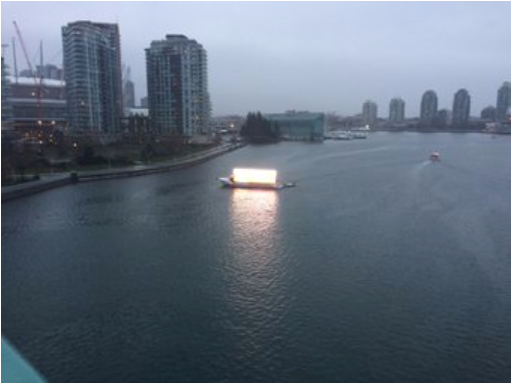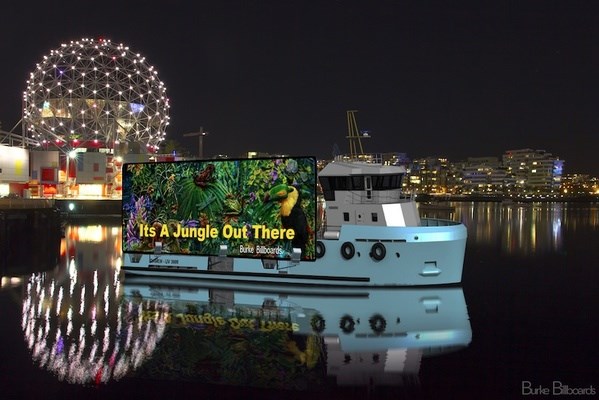An electronic billboard on a boat that made a brief appearance in False Creek earlier this week got a lot of attention, but whether it’s effective advertising is up for debate.
“People are looking for disruptive platforms for breaking through and there’s a very big premium for being the first to do something,” said Alvin Wasserman, principal of Wasserman + Partners, a Vancouver advertising agency.
The moving billboard, which is operated by Burke Billboards, plied False Creek for two days this week. The company did not respond to an interview request.
The boat was detained by Transport Canada on Thursday because it needs to be registered and certified as a commercial vessel. The boat will need to pass a safety inspection before it is allowed back on the water, said Jillian Glover, a spokesperson for Transport Canada.
“They have to meet the requirements of the Canada Shipping Act and appropriate marine safety inspections, so that might involve a stability assessment because they’ve obviously modified the vessel,” Glover said.
It’s not within Transport Canada’s jurisdiction to determine whether the boat is allowed to operate with a billboard attached to it, Glover said.
The City of Vancouver emailed the following to Business in Vancouver in response to an interview request: “The City is looking at its authority to act in respect to the digital sign given the jurisdiction of the federal government over navigation and shipping in False Creek and English Bay.”
Wasserman, who admits that he prefers the scenic waterway without a large, brightly-lit electronic billboard, warned that the sign doesn’t provide consumers with the payoff that makes some advertising palatable. For instance, Facebook or Gmail users are willing to put up with ads because the product is free.
In this instance, it’s not clear what the residents of Vancouver are getting in return for putting up with a billboard many found garish. Disrupting what Wasserman called a "view corridor" could backfire for advertisers.

The Museum of Vancouver (MOV) was one of the advertisers on the billboard. Myles Constable, MOV's marketing and sales manager, said the advertisement was an experiment which the museum did not pay for. The museum has taken notice of the “passionate” reaction from residents, he said, but creating awareness of the museum continues to be a challenge and the billboard’s placement in an area popular with tourists was one of the reasons MOV decided to try it out.
This isn’t the first time electronic billboards have caused a ruckus. The Squamish First Nation put up a billboard on Squamish land next to the south side of the Burrard Bridge in 2009. Residents who live near BC Place complained about light pollution after three digital signs were installed in 2012 by PavCo, the Crown corporation responsible for the stadium and the Vancouver Convention Centre.
In 2012, Seattle's city council banned floating billboards in response to public criticism.
To read the original Business in Vancouver article, click here.



